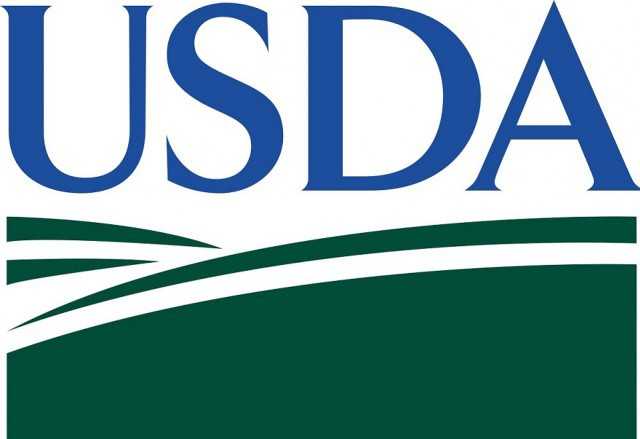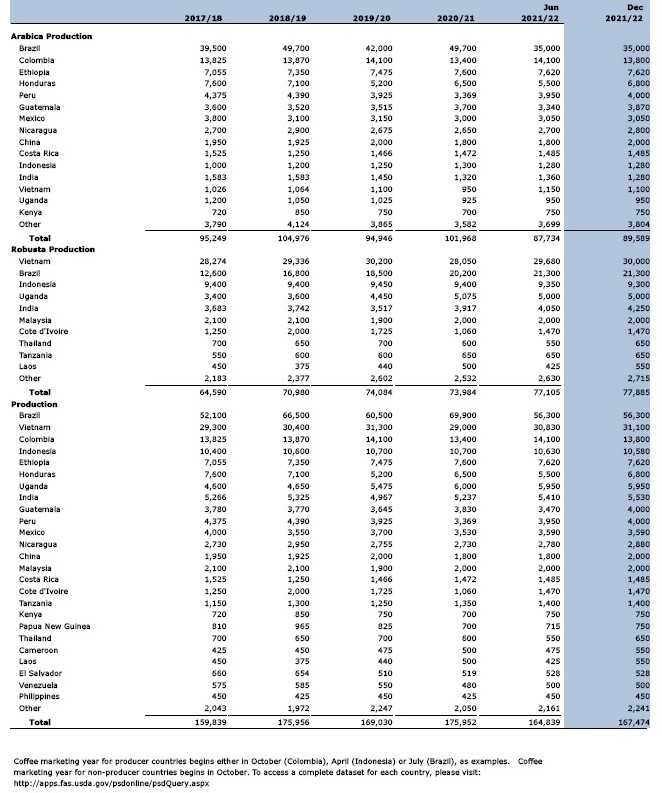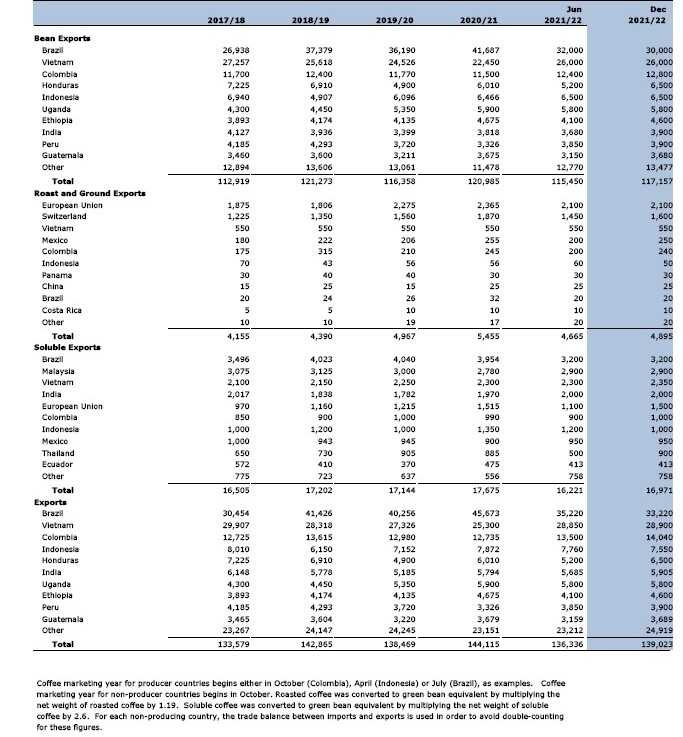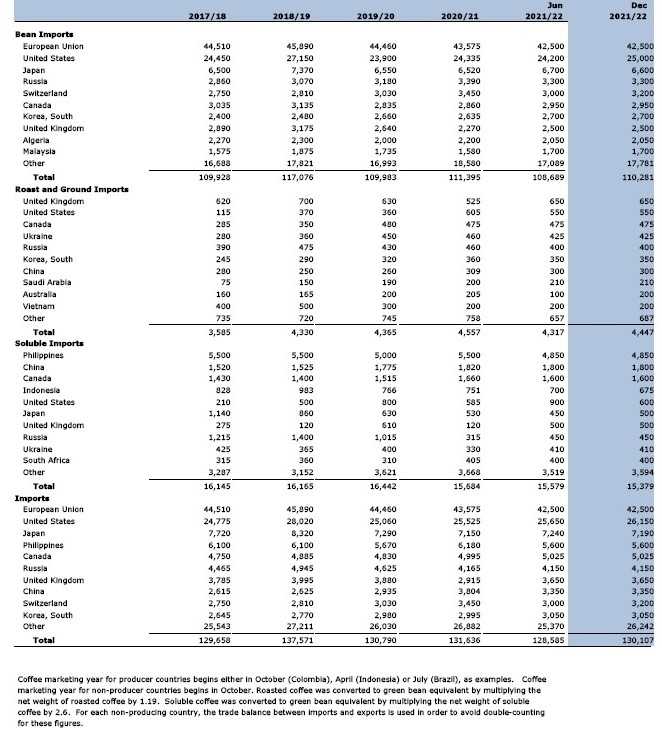WASHINGTON, USA – The USDA ‘s “Coffee: World Markets and Trade” report forecasts world coffee production for 2021/22 down 8.5 million bags from the previous year to 167.5 million, due primarily to Brazil’s combined effect of Arabica trees entering the off‐year of the biennial production cycle and a weather‐related shortfall.
As a result of lower output, global ending inventories are expected to drop 6.3 million bags to 30.0 million. World coffee bean exports are expected down 3.8 million bags to 117.2 million as lower exports from Brazil more than offset higher shipments from Vietnam.
Global consumption rises 1.5 million bags to 164.9 million, with the largest gains in the European Union, the United States, and Brazil.
Brazil production is forecast by USDA down 13.6 million bags to 56.3 million compared to the previous year.
Arabica output is forecast to drop 14.7 million bags to 35.0 million due to lower yields from the off‐year, drought, and high temperatures. The Robusta harvest is forecast to continue expanding to reach a record 21.3 million bags, up 1.1 million. Despite lower output, consumption is expected to continue rising to a record 23.7 million bags. With reduced supplies, bean exports are expected to plunge 11.7 million bags from last year’s record to 30.0 million bags and ending stocks are forecast to decline 500,000 bags to 2.9 million.
Vietnam production is forecast to rebound 2.1 million bags to 31.1 million following last year’s dry growing conditions. With Robusta accounting for over 95 percent of total output and Robusta prices trending higher over the last 12 months, many growers were motivated to boost yields by incurring irrigation costs during the normally drier period of January through March.
Farmers continue to intercrop coffee with fruits, such as avocado and durian, to boost their incomes.
Bean exports are forecast to jump 3.6 million bags to 26.0 million, lowering inventories slightly.
Colombia Arabica production is forecast by USDA 400,000 bags higher to 13.8 million on favorable growing conditions. The National Federation of Coffee Growers of Colombia (FEDECAFE) estimates that nearly 85 percent of coffee area is now planted with rust‐resistant varieties, compared to just 35 percent in 2008/09 when adverse weather conditions caused rust to proliferate, lowering output by one‐third.
Since then, yields have increased about 30 percent due largely to the renovation program that replaced older, lower‐yielding trees with rust‐resistant varieties. The program also reduced the average age of coffee trees from 15 to 7 years, further boosting yields. Bean exports are expected to rise 1.3 million bags to 12.8 million as inventories are drawn lower.
Indonesia production is forecast to slip a modest 100,000 bags to 10.6 million, with most of the loss occurring in Robusta output. Robusta production is expected at nearly 9.4 million bags on mostly favorable growing conditions in the lowland areas of Southern Sumatra and Java, where approximately 75 percent of the crop is grown. Heavy rains in northern Sumatra, where approximately 60 percent of
Arabica output is derived, are expected to have lowered yields, with output down slightly to almost 1.3 million bags. Ending stocks are expected to halve to just 800,000 bags, to sustain rising consumption and strong exports.
India production is forecast to add 300,000 bags to 5.5 million on higher Robusta output in Karnataka, the largest coffee producing state. Arabica is forecast modestly lower as it enters the off‐year of the biennial production cycle. Bean exports are forecast up 100,000 bags to 3.9 million
Total output for Central America and Mexico is forecast up 700,000 bags to 19.4 million on gains in Honduras, Guatemala, Nicaragua, and Mexico. Bean exports for the region are forecast to gain 700,000 bags to 16.4 million due to higher exportable supplies. Nearly half of the region’s exports are destined for the European Union, followed by about one‐third to the United States.
European Union imports are forecast down 1.1 million bags to 42.5 million and account for nearly 40 percent of the world’s coffee bean imports. Top suppliers include Brazil (34 percent), Vietnam (24 percent), Honduras (8 percent), and Colombia (6 percent). Ending stocks are expected to drop 2.5 million bags to 11.3 million to support a modest increase in consumption.
The United States imports the second‐largest amount of coffee beans and is forecast up 700,000 bags to 25.0 million. Top suppliers include Brazil (30 percent), Colombia (21 percent), Vietnam (11 percent), and Nicaragua (5 percent). Ending stocks are forecast to slide 200,000 bags to 5.8 million.
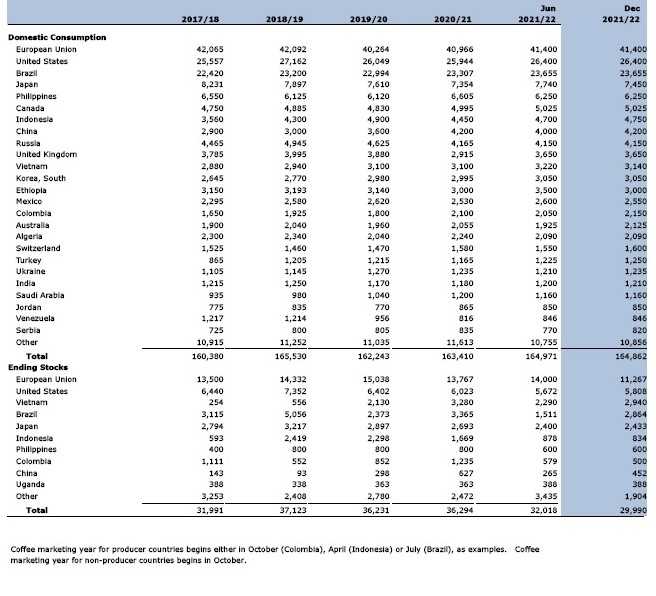 USDA revised 2020/21
USDA revised 2020/21
USDA revised world production for 2020/21 up 100,000 bags from the June 2021 estimate to 176.0 million.
- Colombia is lowered 900,000 bags to 13.4 million due to lower yields from adverse weather conditions.
- Guatemala is raised 500,000 bags to 3.8 million due to higher yields.
World bean exports are raised 700,000 bags to 121.0 million.
- Colombia is lowered 1.0 million bags to 11.5 million on lower exportable supplies.
- Brazil is revised 700,000 bags higher to 41.7 million on higher‐than‐anticipated stocks drawdown.
World ending stocks are lowered 3.6 million bags to 36.3 million.
- European Union is revised 2.3 million bags lower to 13.8 million on updated data from the European Coffee Federation.
- Brazil is lowered 600,000 bags to 3.4 million on higher shipments.



